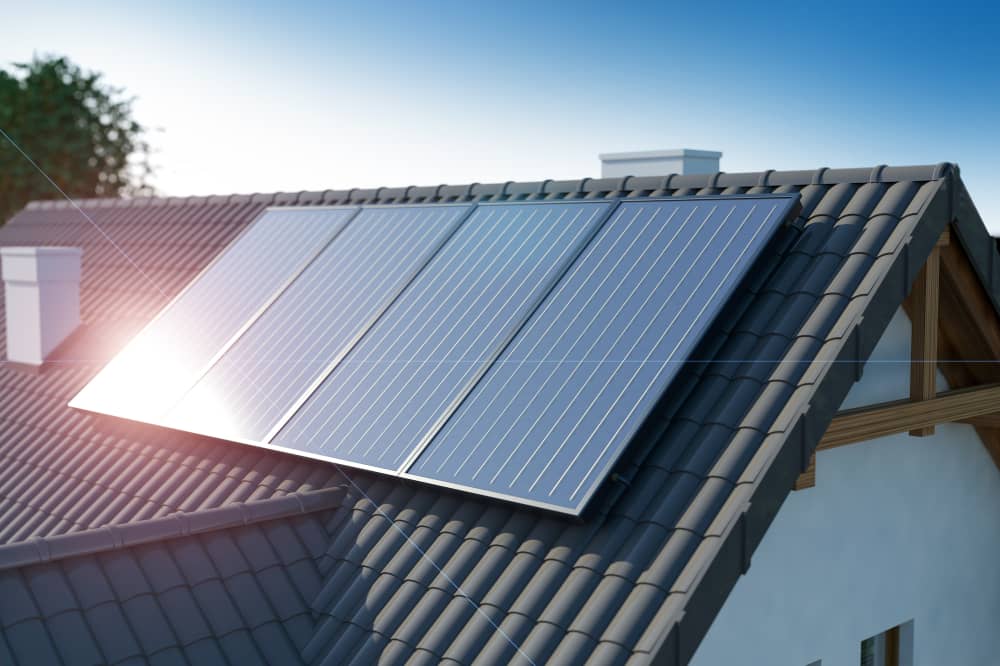lifehacks
Solar Incentives: How to Go Green and Save Big

Last Updated on October 6, 2025 by Joshua Isibor
Solar power can do wonders for your home. Existing infrastructure remains intact, electricity is produced via clean energy, and it reduces your consumption of non-renewable fossil fuels. This isn’t surprising, as the Department of Energy has determined that solar panels are three times more effective than their counterparts.
Unfortunately, powering your home with solar energy isn’t cheap. Thankfully, you can offset the cost by participating in the available solar incentives. They’re a great way to implement a green energy strategy without breaking the bank.
If you’re interested in how to go green and save money, look no further than these solar panel incentives. You’ll learn all about them below.
Low-Interest Loans
Solar incentives such as low-interest loans can help consumers save big and go green. Low-interest loans allow homeowners to spread out their payments over a long period of time, making solar energy more affordable.
These loans can be customized to fit an individual’s budget, making the upfront costs of solar installation more manageable. With this advantage, you may be able to cover all or most of the cost with your tax credits and other incentives in place.
Being able to finance up to 100 percent of the cost of solar installation can help you save thousands of dollars on your energy bills over the course of the loan. And with low-interest rates, you’ll be able to pay off your loan in a more budget-friendly time frame.
Take advantage of solar incentives and low-interest loans to go green and save big.
Property Tax Relief
The attractive incentive of Property Tax Relief is available to homeowners who go green by utilizing solar energy. By investing in solar power and taking advantage of local tax credits and financial incentives, property owners can achieve substantial long-term savings.
Taking a few simple steps, such as installing a solar system or participating in a solar lease, homeowners can start to gain savings on their electricity costs, significantly reducing their monthly expenses.
The federal government also provides an unprecedented tax credit of about 30 percent for solar installations. Local governments typically also offer additional tax credits, refunds, or grants to help offset the cost of installing solar energy systems.
Homeowners can save even more cash by selling the excess solar energy they generate back to the local community. By investing in solar energy and taking advantage of Property Tax Relief, homeowners can go green while pocketing significant savings.
SRECs
Solar incentives, such as Solar Renewable Energy Certificates (SRECs), provide an important incentive for people to go green and save big. SRECs are essentially credits that represent the total clean energy generated by a solar system.
Depending on the state, each SREC is worth roughly 10-25 dollars, which means for every megawatt-hour of solar energy produced on your property, it can potentially earn you hundreds of dollars annually.
Additionally, each state has its own specific SREC program, giving the owner multiple ways to monetize their solar energy production. Additionally, several utilities have announced FIT programs, whereby they buy solar energy at a higher rate, adding further incentive to install solar. With SRECs, homeowners and business owners can go green and save big.
Performance-Based Incentives (PBIs)
Performance-Based Incentives (PBIs) are an effective way to reduce the up-front costs of transitioning to a solar energy setup. PBIs offer customers the opportunity to reduce their improvement costs by leveraging the incentives available from states, utility companies, and the federal government.
PBIs are designed to encourage customers to move to renewable energy sources and reap the long-term benefits of reduced utility bills. By “unlocking” these incentives, customers can dramatically reduce the cost of solar energy installations.
These incentives also help reduce greenhouse gas emissions and their associated health impacts, as well as significant energy savings over traditional sources.
This can help individuals and businesses alike save money in the long run by going green and offsetting the up-front costs. In addition, PBIs allow customers to easily adopt green energy sources with minimal risk.
State Tax Credits
State Tax Credits are an effective way for consumers to save big on solar installations. State Tax Credits give incentives for homeowners and businesses that choose an environmentally-friendly method of powering their buildings.
This breaks down the upfront cost and spreads it out over time in the form of tax credits, making it easier to transition to green energy sources. Consumers can also take advantage of an array of Federal Tax Credits that cover up to 30% of the total installed cost.
Some states also have their own renewable energy credits that cover a portion of the remaining cost, which can vary by state. When taken all together, these incentives can make going solar even more affordable and can help save people thousands of installation costs.
Homeowners should check with their state and local governments to see what solar incentives are available in their areas. Utilizing these credits can make it much easier to transition to a green energy source and provide real savings in the end.
State Government Rebates
State Government Rebates are one of the best ways to go green and save big on solar energy. These generous incentives, which are available in many states, help to make the cost of installing solar panels and other solar energy technologies more affordable for homeowners, businesses, and local government entities.
Depending on the state, rebates are typically awarded on a first-come, first-served basis, so it is important to apply as soon as possible. Rebates generally cover up to 25-50% of the cost of installing a solar energy array on a single residence or small business.
In addition to state-backed incentives, some municipalities and utilities may also provide lower rates for solar energy installations. Solar energy is becoming increasingly affordable, and with the right incentives and rebates, going green can be the smartest and most economically sound choice.
Local Utility Rebates
One way to invest in sustainability and save money is through local utility rebates for installing solar panels. Generous incentives may be offered to customers who install solar technology in their homes for reduced rates on electricity costs.
These rebates help to defray the up-front installation costs of solar, which can be thousands of dollars. Additionally, in some cases, customers are eligible for additional solar tax credits or cash rebates from their local utility or state.
For example, in California, customers may be eligible for a rebate from their local utility company as soon as the solar equipment is installed. In other states, solar incentives may include income tax credits for the purchase of renewable energy systems or special rates for green energy sources. With local utility rebates, customers can go green and save big.
Subsidized Loans
Solar incentives are a great way to go green and save big. Subsidized solar loans are specifically designed to help homeowners and businesses with the upfront cost of switching to solar. These low-interest, long-term loans can enable households to pay back the cost of their solar energy system over an extended period of time.
Not only do subsidized loans make going solar easier, but they can also help those with a limited budget save money on energy bills in the long run.
To be eligible for a subsidized loan, you must meet certain requirements, such as having a good credit score, and your system must meet certain specifications. Subsidized solar loans are an important financial tool to help encourage the switch to renewable energy and make it easier for households of all sizes to save money in the long run.
Tax Exemptions
Tax exemptions are one of the largest solar incentives when it comes to transitioning to green energy. Many states offer exemptions on personal solar income tax to those who invest in solar.
Additionally, some local areas offer exemptions on property tax for solar energy systems. When combined with Federal Tax credits, having a solar energy system installed can be significantly less expensive.
Solar energy systems do away with traditional energy bills, which can result in significant long-term savings. All of these incentives make it easier to transition to green energy without breaking the bank.
In order to take advantage of all the available solar incentives, it’s important to research and understand the local, state, and federal tax laws. Doing so can make all the difference when it comes to going green and saving big.
Net Metering Program
Net Metering is a program that is available to property owners who invest in solar energy and allows them to reduce their overall energy costs by allowing them to be compensated for the excess energy they generate.
This program allows customers to register with the utility company and receive compensation in the form of credits on their energy bills for the energy they generate. This makes it easier for homeowners, businesses, and solar energy users to save money on their energy costs.
Additionally, the program encourages customers to switch to renewable energy sources, making it easier for them to reduce their carbon footprints. Furthermore, many states offer incentives for customers who use net metering to switch to solar energy.
This can reduce the cost of installing a solar energy system and make it easier for property owners to transition to cleaner, more affordable energy sources. Finally, these net metering programs can provide consumers with financial stability and the potential for increased savings over time.
Solar Feed-in Tariff
Solar Feed-in Tariff is an incentive program that offers homeowners and businesses the opportunity to go green without breaking the bank. It encourages the use of renewable energy, such as solar power, by offering money for solar-generated electricity that is fed back into the power grid.
This money is awarded for the electricity generated through any eligible solar installation. By taking advantage of this incentive, individuals can significantly reduce their overall energy costs, reduce their usage from the grid, and generate electricity from a clean, renewable energy source.
Through Solar Feed-in tariffs, homeowners and businesses alike can save money and help reduce climate change all at the same time.
Investment Tax Credits
Investment Tax Credits (ITCs) are a powerful financial incentive that can help individuals or businesses save money as they transition to renewable energy sources. The ITCs provide a 30 percent non-refundable credit for costs associated with installing and operating a solar energy system.
This means that for every dollar spent on a solar installation, the taxpayer will be refunded 30 cents. With the substantial cost reductions that are associated with going green, taxpayers can reduce energy costs, reduce their carbon footprint and save money on their taxes.
With increased governmental incentives and policy changes, solar power is becoming increasingly available and accessible to all Americans. Taxpayers can take advantage of ITCs to save big on their investment in solar while also helping to reduce the negative impacts of global warming.
These incentives help make clean energy access more affordable and provide an important step towards developing a more sustainable future.
Cash Rebates
Cash rebates are offered by many states and local governments to encourage the installation of solar energy systems. These cash rebates provide an important incentive that can help individuals and businesses save big on their solar energy installation costs.
Depending on the size and type of installation, rebates may be available that could save individuals and businesses up to 50% of the costs of their solar energy installations.
Depending on the location and type of installation, some solar energy systems may also carry additional incentives and tax credits that may further reduce the out-of-pocket costs of the system.
To obtain cash rebates for solar energy, individuals and businesses should contact their local and state governments to see what programs and incentives are available in their area.
Doing so can help to drastically reduce the cost of installing a solar energy system and make the process of going green and saving big cash a much more affordable reality. Read more now about solar panel installation to get started.
Learn More About Solar Panel Incentives
Going green and investing in solar panels can not only help you save money in the long run but can also reduce your carbon footprint and save the planet. Research specific solar panel incentives and see how you can benefit from them.
Did you find this article helpful? Check out the rest of our blog for more!
Also, Read Why is it crucial to protect your messengers
Originally posted 2023-05-14 07:53:20.

-

 Text Messages2 years ago
Text Messages2 years agoBEST LOVE CONFESSION MESSAGES FOR HER OR HIM
-

 Health3 weeks ago
Health3 weeks ago5 Unknown Ways To Maintain Skin Health
-

 Sex Education4 months ago
Sex Education4 months ago10 Simple Hack to Make a Girl Send Her Nudes
-

 Text Messages2 years ago
Text Messages2 years agoHappy Birthday Cousin, wishes and messages
-

 Text Messages2 years ago
Text Messages2 years agoHeart Touching RIP Uncle Quotes
-

 Uncategorized2 weeks ago
Uncategorized2 weeks agoHOW TO KISS A BOY FOR THE FIRST TIME
-

 Text Messages2 years ago
Text Messages2 years agoBest Good Luck Wishes Before and After Surgery, for Family and Friends
-

 Text Messages2 years ago
Text Messages2 years agoFreaky and Dirty Paragraphs For Him Copy And Paste Yahoo













